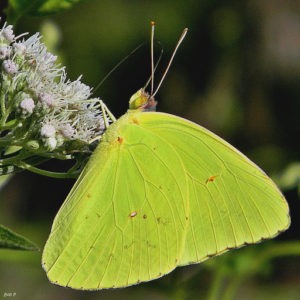Sulphur butterflies are the bright yellow butterflies with relatively few markings that we see in our gardens and other open areas during the summer and fall. Of the medium to small sized butterflies, sulphurs are some of my favorites. There are several species of sulphur butterflies that can be found in Kentucky and much of the eastern U.S. Many of the species look fairly similar and are often generically grouped together as simply sulphur butterflies. The cloudless sulphur butterfly (Phoebis sennae) is one of the largest, most common, and easily identified of the sulphur butterflies.

Adult sulphur butterflies feed on the nectar from a variety of flowers. After mating, the female will lay one egg per plant on partridge pea and related plants. The egg will hatch in approximately six days.
The caterpillar can either be mostly green or mostly yellow and will have both stripes and spots. One reference I found said that the yellow caterpillars were ones that were primarily feeding on flowers and the green caterpillars were primarily feeding on the leaves and stems. I couldn’t confirm whether that was true, but it wouldn’t be the first time that an animal’s diet influenced its color.
When the caterpillar pupates, the chrysalis is either green or pink with yellow or green stripes. Both types of chrysalis look like a folded leaf with the pink one looking like a diseased or stressed leaf that just hasn’t fallen off yet.
Like the monarch butterfly, multiple generations of sulphur yellow butterflies may occur in one summer in Kentucky. The number of generations a butterfly produces across its range often increases the further south one goes and decreases the further north one goes. Both the monarch butterfly and the sulphur butterflies follow this pattern.
Also like the monarch, the cloudless sulphur butterflies migrate south in the fall. Cloudless sulphur butterflies fly fairly low when they are migrating and thus are easy to spot. That’s why we sometimes see so many sulphur butterflies during the late fall. Monarch butterflies, on the other hand, fly relatively high when they are migrating which can make it more difficult to see them.
Many of the cloudless sulphur butterflies in the eastern U.S. overwinter in middle to southern Florida. One study indicated that most of these butterflies overwinter south of Gainesville and north of Lake Okeechobee. In the spring, the butterflies that overwintered in Florida will make their way north again and start the process over again.

This article was part of Shannon’s original Kentucky Pollinators and Backyard Wildlife blog which evolved into the blog for Backyard Ecology.

Backyard Ecology: Exploring Nature in Your Backyard
Nature isn’t just “out there.” It’s all around us, including right outside our doors. Hi, my name is Shannon Trimboli, and I am the host of Backyard Ecology. I live in southcentral Kentucky and am a wildlife biologist, educator, author, beekeeper, and owner of a nursery specializing in plants for pollinators and wildlife conservation. I invite you to join me as we ignite our curiosity and natural wonder, explore our yards and communities, and improve our local pollinator and wildlife habitat. Learn more or subscribe to my email list at www.backyardecology.net.

Leave a Reply